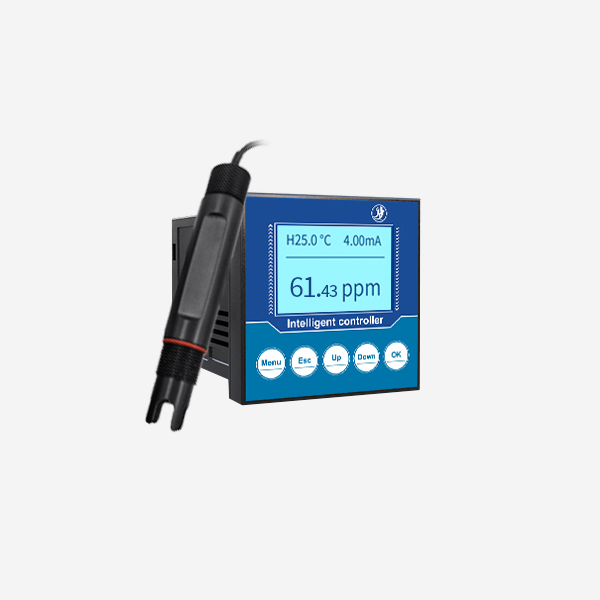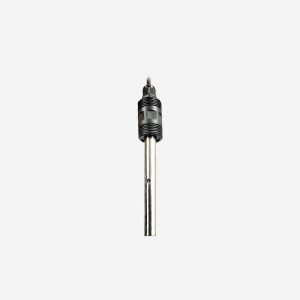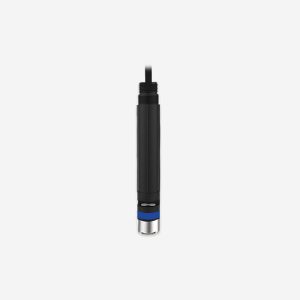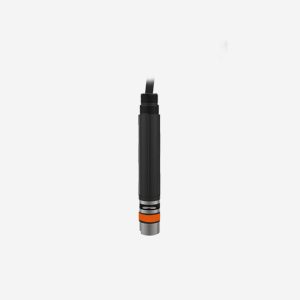Product Introduction:
Residual Chlorine sensor is one of the intelligent online chemical analysis instruments. The Residual Chlorine electrode used in this product is a diaphragm polarographic (Clark) type sensor, consisting of a cathode, anode, electrolyte and a layer of gas permeable film covered on the cathode. The residual chlorine in the measured solution diffuses to the cathode through the diaphragm, and the appropriate polarization voltage between the cathode and the anode can reduce the residual chlorine in the cathode. These chemical reactions produce a current proportional to the residual chlorine in the measured solution. This product is suitable for medicine, environmental protection, tap water monitoring, drinking water, industrial process water disinfection and sterilization process of residual chlorine concentration online monitoring, can also be used for swimming pool, aquaculture and other need to measure residual chlorine concentration places. This product with waterproof shell, the water solution signal through digital tuning analysis, converted into the standard 485/4-20mA/0-10V signal. Product molding without calibration, can be used at first hand.
* Models:JXBS-3001- Residual chlorine
* Minimum order quantity: 1 piece
* Delivery time: within 24 hours
Features:
1. measurement accuracy
2. long life
3.it is easy to operate
4. signal stability

Parameters:
Determination parameters: residual chloride ion
Measuring range: 0-2mg/L
Measurement principle: three electrode electrochemistry
DC power supply: 12-24V DC
Power consumption: ≤0.15W(12VDC, 25)
Measurement accuracy: ±5.0%
Response time: 30s
Output signal: RS485/4-20mA/0-10V
Operating temperature: 5~50℃
Medium PH range: 4~9PH
Attention:
1. Set the system
Buzzer Setting: Sets the buzzer switch when the alarm is generated.
Backlight Settings: You can set the background brightness and on-screen duration.
Password Change: Allows you to enable or disable the password and change the password.
Factory Settings Specifies whether to restore factory Settings
2 Signal Setting
Electrode type: Set the type of electrode. There are two types: residual chlorine electrode and conductivity electrode.
Temperature compensation: Set automatic or manual temperature compensation, temperature range -20-80℃
3 Online calibration
Residual chlorine calibration: After entering the residual chlorine calibration screen, first put the residual chlorine electrode into the 4.00 residual chlorine standard solution and let it stand for a while. After the indicating number is stable, press the [Confirm] button. Then put the residual chlorine electrode into the 6.86 residual chlorine standard solution and let it stand for a while until the indicating number is stable. Let it stand for a while, and press the “Confirm” button when the number is stable. After the calibration is displayed successfully, the residual chlorine calibration process is over.
Residual chlorine correction: The measured residual chlorine can be corrected.
4 Configure remote transmission
Remote Setting: includes two communication modes: 485 and analog. RS485: Sets the communication address and baud rate of the 485.
Emt: Set the corresponding value of 4mA and the corresponding value of 20mA for 4-20mA output.
5 Alarm Setting
Residual chlorine high alert: when the measured value is greater than the high alert suction value, the high alert relay will pull on; when the measured value is less than the high alert disconnection value, the high alert relay will disconnect.
Residual chlorine low alarm: When the measured value is less than the low alarm suction value, the low alarm relay suction, when the measured value is greater than the low alarm disconnect value, the low alarm relay disconnected.
6 Information Query
Version information: Query the current version of the hardware and software

FAQs:
1. In what form does residual chlorine exist in water?
There are three forms of residual chlorine in water: total residual chlorine, free residual chlorine and combined residual chlorine.
Combined residual chlorine, also known as combined residual chlorine, refers to the chlorine and ammonia compounds in water.
Free residual chlorine, also known as free residual chlorine, refers to OC1+, HOCl, Cl2 and so on in water. It has fast bactericidal speed and strong bactericidal power, but it disappears quickly.
Total residual chlorine is the sum of bound and free residual chlorine.
2. How do I maintain the residual chlorine electrode?
Chlorine sensors generally do not require routine maintenance. When there is an obvious fault, please do not open the repair, and contact us as soon as possible!
After using the chlorine electrode, clean the electrode head with clean water and cover it with a protective cover.
If dust and mineral components adhere to the electrode diaphragm, sensitivity is reduced and adequate measurements may not be possible. Make sure the platinum ring is clean.
Good residual chlorine electrode platinum induction ring should always be kept clean and bright. If the platinum ring of the electrode becomes rough or contaminated after measurement, please clean it in the following way: (for reference).
1. Inorganic pollution: Immerse the electrode in 0.1mol/L dilute hydrochloric acid for 15 minutes, gently wipe the remaining chlorine electrode platinum ring with a cotton swab, and then clean it with tap water.
2, organic matter or oil: the electrode is immersed in the tap water containing a small amount of detergent (such as dish soap), thoroughly clean the induction surface of the electrode sensor. Gently wipe the platinum ring of the electrode with a cotton swab, then rinse with running water to complete the cleaning. If the electrode platinum ring has formed an oxide film, please use toothpaste or 1000 mesh sandpaper to moderately sand the sensor surface, and then wash with running water.





Reviews
There are no reviews yet.